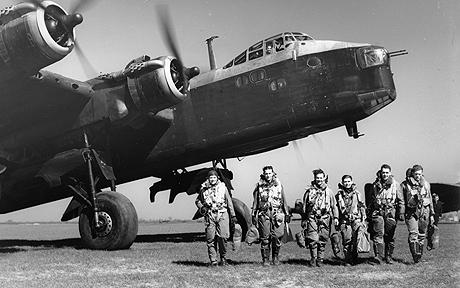The 35 Sqdn left from Graveley at 1943-02-04 at 18:47
He flew with a Handley Page Halifax (type II, serial W7923, code TL-D).
Campaign report of the USAAF:
(Eighth Air Force): Lieutenant General Frank M. Andrews, USAAF, assumes command of the European Theater of Operations, US Army. (Also see WESTERN MEDITERRANEAN below.) VIII Bomber Command Mission 33: 65 B-17s of the 1st Bombardment Wing and 21 B-24s of the 2d Bombardment Wing are dispatched against the Hamm, Germany marshalling yards. The B-24s turn back before hitting the Dutch coast when the temperature drops below the lowest limit of the thermometers (-40 degrees C). Heavy clouds cover Hamm so three of four B-17 groups (39 B-17s) attack the marshalling yard, port area and industries in Emden, Germany between 1200 and 1215 hours local dropping 92.25 tons of bombs. We claim 25 enemy fighters destroyed, 8 probably destroyed and 6 damaged; 5 B-17s are lost; human casualties are 17 WIA and 50 MIA. Bombers are opposed for the first time by Ju 88 and Me 110 twin-engine fighters. The 4th Fighter Group dispatches 21 Spitfire Mk Vs on uneventful fighter patrols and an air-sea rescue search.
Campaign report of the RAF:
3/4 February 1943
263 aircraft - 84 Halifaxes, 66 Stirlings, 62 Lancasters, 51 Wellingtons - provided by all groups on the first 200-plus raid for more than 2 weeks for a raid on Hamburg. Icing conditions in cloud over the North Sea caused many aircraft to return early. The Pathfinders were unable to produce concentrated and sustained marking on H2S and the bombing of the Main Force was scattered. The results in Hamburg were no better than the attack by a much smaller force a few nights earlier. The German night fighters operated effectively, despite the bad weather, and 16 bombers were lost - 8 Stirlings, 4 Halifaxes, 3 Wellingtons and 1 Lancaster, 6.1 per cent of the force.
8 Wellingtons minelaying off Lorient and St Nazaire, 4 OTU sorties. 1 Wellington minelayer lost.
4/5 February 1943
188 aircraft - 77 Lancasters, 55 Halifaxes, 50 Stirlings, 6 Wellingtons ordered to Turin of which 156 reached the target. Elsewhere in Italy, 4 Pathfinder Lancasters were sent to this Italian port to try out a new type of 'proximity fuzed' 4,000lb bomb which exploded between 200 and 600ft above the ground to widen the effects of the resulting blast. 3 aircraft dropped their bombs successfully, but this type of weapon does not seem to have come into general use. 3 Lancasters, all from the Turin raid, lost.
128 aircraft - 103 Wellingtons, 16 Halifaxes, 9 Lancasters attacked Lorient. 1 Wellington lost. This was an all-incendiary attack without the Pathfinders. Bombing was concentrated and large areas of fire were started.
Finally, 2 Mosquitos bombed Bochum and Ruhrort and 1 Wellington laid mines off Lorient
With thanks to the RAF and USAAF.net!
This record can also be found on the maps of Back to Normandy with Google coordinates. You can find the maps by clicking on this link on this location.
There are several possibilities to investigate the flight records on Back to Normandy. All the flights are plotted on maps, sorted "day by day", "by squadron", "by type aircraft", "by year or month", "by location" and much more! Don't miss this!!!
If you have any information that you want to share, please add your comment at the bottom of this record. Or send your information to [email protected]. This information will be added to the record.
Your photos and your information are very welcome! The young do care and with your help we keep up the good work.



